While several large-scale prosthetic films were not finalists for best makeup at the 2014 Oscars, including such movies as the newest fantasy-driven Hobbit installment plus detailed period and realism in makeup as was featured in the 1970s car racing film Rush, the Academy’s makeup artistry and hairstyling branch selected three films whose work represented the best in what artists in this field offer to a wide array of productions.
Dallas Buyers Club – Robin Mathews & Adruitha Lee
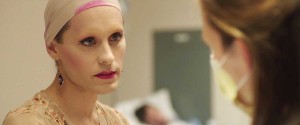
For the project, Mathews was required to visually present a panoply of makeups and characters for the tale of Matthew McConaughey’s Ron Woodroof, a 1980s AIDS survivor who helps other patients find unapproved medication to stave off the deadly disease. Another main character, Jared Leto as Rayon, was both a patient and a transsexual. “I really throw myself into the research of any film I do,” Mathews reflected about undertaking the project. “I went to the head doctor of infectious diseases at the National Institute of Health. I got very descriptive answers and photos.”
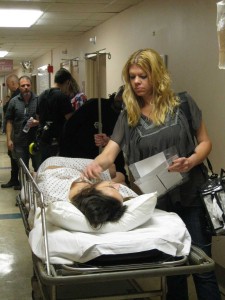
If that challenge were in and of itself not already daunting, Dallas Buyers Club’s shooting company completed principal photography out-of-sequence in only 23 production days. Moreover, the film shot non-stop with a handheld camera, utilizing only ambient lighting – no grip and electric equipment or crew were used. “The schedule was built around the art department’s needs,” Mathews explained. “We would go from Jared and Matthew’s healthiest look to when they are dying of AIDS.” These drastic changes, sometimes five within one shooting day, involved Mathews completely altering both McConaughey’s and Leto’s full makeups.
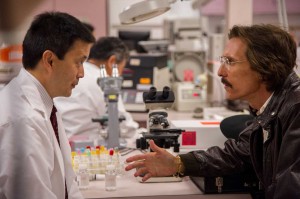 To assist the verisimilitude that this true story warranted, both McConaughey and Leto lost 40 pounds each, and through the 23-day shoot, they maintained that weight loss. Of note, Leto came onto the project after it had been shooting, so production only had his full services for two weeks. That said, Mathews was tasked with making all facial and body changes, and maintaining each look consistently through the shoot. “I like to say the only time the camera wasn’t rolling was during lunch and during makeup changes,” she stated. “It was the most exhausting 23 days I’ve ever shot. I had a key makeup artist and one additional artist come in to help with background AIDS patients for three days. It was kamikaze filmmaking at its best. It made an amazingly beautiful energy for the story, and it worked.”
To assist the verisimilitude that this true story warranted, both McConaughey and Leto lost 40 pounds each, and through the 23-day shoot, they maintained that weight loss. Of note, Leto came onto the project after it had been shooting, so production only had his full services for two weeks. That said, Mathews was tasked with making all facial and body changes, and maintaining each look consistently through the shoot. “I like to say the only time the camera wasn’t rolling was during lunch and during makeup changes,” she stated. “It was the most exhausting 23 days I’ve ever shot. I had a key makeup artist and one additional artist come in to help with background AIDS patients for three days. It was kamikaze filmmaking at its best. It made an amazingly beautiful energy for the story, and it worked.”
Mathews’ makeup assistant tag-teamed McConaughey’s makeups with her. As Mathews was doing facial makeup, her assistant was doing bodily makeup applications to make actors look heavier or thinner, as the scene required. “Some days, I would just stay in the trailer doing makeup changes and she would run the set,” Mathews described. “I would run to set, check the levels in the light, and run back to the trailer to do a makeup change.”
To execute the various looks, Mathews and McConaughey closely collaborated in creating a detailed plan. “Matthew and I broke this down and came up with the makeup changes, the different levels of sickness, and where they would start taking effect,” said Mathews. “Matthew had five levels of sickness and his healthy look, and Jared had four levels of sickness and his healthy look. My assistant and I each had the breakdown on paper, on our phones, and in our makeup bags. It was a very detailed breakdown. It was our bible that we followed.”
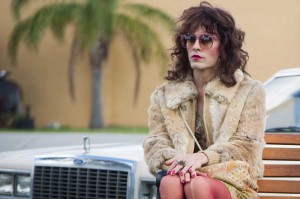 For McConaughey’s healthiest makeup stage, Mathews gave him an overall tan, did a reverse highlight and shadow makeup, and added upper dental plumpers to fill out his face. Then, his first level of sickness was accomplished by removing the plumpers and downgrading his appearance with highlight and contour makeups. Later phases involved adding the rash then lesions towards the very end stages.
For McConaughey’s healthiest makeup stage, Mathews gave him an overall tan, did a reverse highlight and shadow makeup, and added upper dental plumpers to fill out his face. Then, his first level of sickness was accomplished by removing the plumpers and downgrading his appearance with highlight and contour makeups. Later phases involved adding the rash then lesions towards the very end stages.
However, the bodily makeups, which made actors appear thinner and heavier as needed, were equal to the process of changing their faces. “I lined the trailer walls with pictures of skeletons,” Mathews revealed about her point of reference which led to her highlighting and contouring the actors’ every visible bone plus protruding veins. “That made them look even thinner. We see Jared’s whole body a lot. That involved hours of highlight and contour on every single bone in his body.”
For Leto, a further transsexual beauty makeup was added on top of his illness visages. “I had to use the real products from 1985 to look authentic,” Mathews conveyed about the period look of the film. “Rayon takes female hormones when she can, but she’s a hustler. Her nails and eyelashes are coming off. All of this going on while underneath, we needed to be able to see the damage that the disease was doing to her body.”
Similar to McConaughey’s, Leto’s healthy stage involved a reverse highlight and contour to make the character full-faced, with a “clean” beauty facial makeup. “When she gets more and more sick, she looks splotchy, and is a drug abuser and picks at her skin,” Mathews detailed.
Toward the end of the story, when Rayon is at her worst, Mathews condensed the application process to an hour and a half. “I was trying not to make as many drastic makeup changes in between,” Mathews noted. “There were days where Rayon was in makeup five-six hours a day because she had so many makeup changes. Jared’s tattoos were removed from his arms, chest, and back of his legs with skin illustrator alcohol palette. It would last all day. Matthew’s makeups were much quicker.”
One would think that a schedule which mandated many daily makeup changes might become notably impractical, and Mathews brought this to the attention of production. “Many times, we went to the first AD and to the director and said, ‘Please you’ve got to rearrange the schedule — I’m worried about their skin,’” Mathews recalled. “It was a $4.5 million budget. Locations were already reserved and bought. At that point, the ball was already rolling too far down the hill. It was a mistake from the beginning that wasn’t able to be corrected, but it all turned out great.”
Jackass Presents: Bad Grandpa – Stephen Prouty
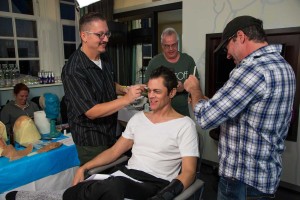
To realize Knoxville’s look some 40 years beyond his current age, Prouty created a full head makeup concept which broke down into 11 individual pieces plus separate appliances for each hand. Knoxville wore those 13 pieces through most of the shoot, with two days in which he additionally wore two large foam latex body pieces – one on the front and one on the back. Prouty described the full body appliance as “a piece [which] ran from his collarbone to his crotch. Those were sculpted by David Smith. We had some additional sculptors to produce the appendages – different incarnations of his genitalia.”
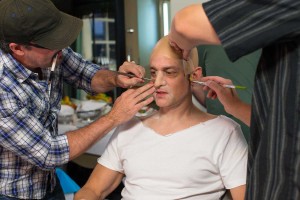 As Prouty required a means to hold down Knoxville’s hair down, Alterian fashioned a latex baldcap, most of which would be covered by appliances after the makeup was complete. The rest of the makeup consisted of a nose piece which would be applied first, a combined neck-and-cheeks piece, a set of ears, a back-of-the-neck piece, a forehead, two eyelids and separate lips. “Most of it was silicone,” Prouty explained of the materials used for the appliances. “We did go with an encapsulated bondo for the lips and back of the hands. Johnny Knoxville is expressive, so we needed something to withstand over-the-top expression and hands. We had one day when a knuckle came loose, but we never touched them up on the show.”
As Prouty required a means to hold down Knoxville’s hair down, Alterian fashioned a latex baldcap, most of which would be covered by appliances after the makeup was complete. The rest of the makeup consisted of a nose piece which would be applied first, a combined neck-and-cheeks piece, a set of ears, a back-of-the-neck piece, a forehead, two eyelids and separate lips. “Most of it was silicone,” Prouty explained of the materials used for the appliances. “We did go with an encapsulated bondo for the lips and back of the hands. Johnny Knoxville is expressive, so we needed something to withstand over-the-top expression and hands. We had one day when a knuckle came loose, but we never touched them up on the show.”
When Prouty first started Bad Grandpa, he asked for three-and-a-half hours to apply the full makeup. Eventually, applying the complete head and hands took two hours and 45 minutes. “Bart Mixon came out to help me and Will Huff,” Prouty said of his assistant makeup artists who production agreed to keep on the makeup crew. “That sped that up. Three of us working on him the whole show.”
Surely, with the entire film riding on the makeup, Prouty needed to create a consistent look while being mindful of Knoxville’s time spent in the chair throughout production. “I timed our makeup every day on my iPhone so that production knew we were sticking to our time schedule,” Prouty recalled. “All of the appliances were on in an hour-and-fifteen-minutes. Then an hour of painting and 30 minutes of hair work. I was very happy that we were able to get those times.”
Prouty and his team added skin illustrator and rubber mask grease paint to the applied prosthetics then included a wig, moustache and eyebrows. Following that, the makeup artists would hand-lay hair on Knoxville neck, in his ears, and across his full body – chest, abdomen and shoulder hair. “Basically, in the morning, they would allot us about four hours of time end-to-end to get ready,” Prouty stated.
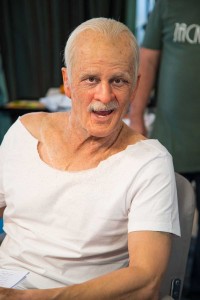 With Mixon and Huff, Prouty created the full makeup on Knoxville for 61 days of filming. “The way we shot the film is we would go on location and do two-three weeks and then be down in Los Angeles for several weeks,” he said. “It stretched out in close to ten months of shooting. It was unique, but it actually made sense given the context of the film.”
With Mixon and Huff, Prouty created the full makeup on Knoxville for 61 days of filming. “The way we shot the film is we would go on location and do two-three weeks and then be down in Los Angeles for several weeks,” he said. “It stretched out in close to ten months of shooting. It was unique, but it actually made sense given the context of the film.”
From beginning of makeup to wrap, Bad Grandpa averaged 12-hour days with approximately 8-10 hours of shooting. “We didn’t have traditional makeup trailers,” Prouty revealed. “We did the touchups in the back of a minivan when we were driving to the next setup. The touch-ups consisted of re-gluing the moustache at the corners. The lace is fairly rigid, so it doesn’t flex. Some was weather related, but overall, the touchups were fairly minimal. We were there all day with him.”
After wrap, removal of Knoxville’s makeup averaged 40-50 minutes. “All three of us attacking him at once,” said Prouty. “Split it up the back and take it all off in one big heap. As the summer months wore on, it made it a lot easier with the sweat.”
Now, with Prouty nominated for best makeup, the Bad Grandpa makeup stands tall amongst other great old-age makeups from film history. “It’s crazy and incredible,” Prouty remarked. “It is truly a honor just to be here. The makeup artist and hairstylist branch, they recognize the work and took us to this point. I’m very appreciative of that.”
The Lone Ranger — Joel Harlow And Gloria Pasqua Casny
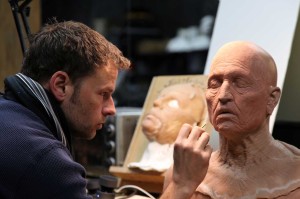
After Harlow suggested that he create a test makeup based on I Am Crow using actor Depp, photographs of the eventual test circulated to Pirates’ principals Jerry Bruckheimer and Disney and helped get Lone Ranger greenlit. “Once the movie was greenlit, our first big hurdle was the old man Tonto that you see in the diorama,” Harlow said of the initial scenes in the schedule, shot on stages in Albuquerque, New Mexico. “Mike Smithson and I jumped into that. It was an eight-hour silicone makeup — 17 [prosthetic] pieces, two contact lenses in each eye, fingernails, an old wig and old bird. We pre-punched hair into the pieces – arms, hands, chest, shoulders, nose, chin, ears – every prosthetic except his eyebags.”
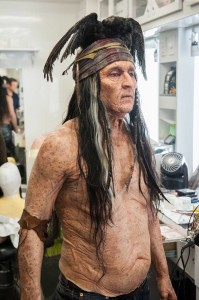 For the 110-year-old Tonto makeup, which would be filmed in a diorama lighting scenario, Harlow noted special challenges. “It works against you in that it’s not atmospheric,” he said, “but you get a side lighting and rim lighting. You want to do it, test it, refine it, but we had no option. We did a test version that was ultimately not the one that was in the film.”
For the 110-year-old Tonto makeup, which would be filmed in a diorama lighting scenario, Harlow noted special challenges. “It works against you in that it’s not atmospheric,” he said, “but you get a side lighting and rim lighting. You want to do it, test it, refine it, but we had no option. We did a test version that was ultimately not the one that was in the film.”
To realize old Tonto, a month-and-a-half of sculpting the head and shoulders and arms was required. “Mike sculpted the chest and second set of arms and hands,” Harlow said, noting that he resculpted the head and shoulders for camera while Smithson resculpted the arms. “The chest and back giant wraparound piece stayed [from the first sculpture]. He went into the makeup about five times, with additional days of hands and arms. If that makeup failed up front of a 153-day shooting schedule, the next 140 days would have miserable.”
For the remainder of the film, Depp performed in the young Tonto makeup, doing so 90 times. “Seven prosthetics on his face and four more on his arms,” Harlow noted of the finished makeup. “The initial test was all done with color; the final makeup, I consulted with the Comanche specialist that the production brought on. I wanted to give him that clay-ash mud look. Like the cannibals in Pirates 2. There’s no way to track that through a long production schedule. I decided to do it as a prosthetic.”
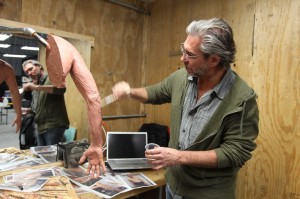
To create Depp’s “smeared mud” look, Harlow molded sections of molten clay on Depp’s lifecast and fashioned silicone pieces from those sections. Painting the final makeup involved enhancing the earthen look. “We had to base his body out in a terracotta because Gore was specific on the color we wanted his skin can be,” Harlow stated. “We based out his whole body, and dry brushed his face and arms.” Makeup artist Kenny Niederbaumer, another Pirates vet, assisted in this process.
Of course to get Depp’s makeup perfect but be mindful of the star’s full schedule for 90 shooting days, Harlow needed to streamline the process. “All in, it took an hour-ten minutes down from an hour-45,” he said. “After painting, I designed a vacuum-formed skull cap to keep the bird on his head.” Then, Harlow and hair department head and co-nominee, hair department head Gloria Pasqua Casny, creatively designed a seamless sewed-lace, nut, and rod system for placement of the bird which allowed them to change out the bird without having to take off Depp’s wig.
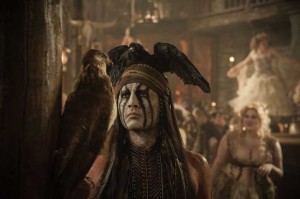 As would be expected, 40 minutes of Depp’s makeup involved putting on the prosthetics, but the remainder of Depp’s character was achieved very quickly. “The painting was fast and the bird was really fast,” Harlow said. “The final touches of dry brushing, and parchment yellow color, and white face. Gloria would pop the wig on, and he’s ready to go.”
As would be expected, 40 minutes of Depp’s makeup involved putting on the prosthetics, but the remainder of Depp’s character was achieved very quickly. “The painting was fast and the bird was really fast,” Harlow said. “The final touches of dry brushing, and parchment yellow color, and white face. Gloria would pop the wig on, and he’s ready to go.”
With a mammoth 153-day shoot, over and above creating Depp’s appearances, Lone Ranger was a huge enterprise, but Harlow was well prepared for the length of the project. “It was fun,” he reflected, “because I could put my stylistic stamp on it. Because I did the Pirate movies, department headed the last one, I was following suit. In this one, I could push it and do things that I always wanted to do.”
In point, one Lone Ranger sequence called “Hell on Wheels” involved the main characters riding into a new town. “There were characters there not in the script,” Harlow commented. “Mike and I threw out ideas, and Gore said to make them and, ‘I’ll throw a camera on them.’ Mike played a ventriloquist whose mouth was sewed up, [there was a] goat skeleton guy, and the geek with his entire body keloided with scars and tattoos in different symbols. Visual excitement for the background.”
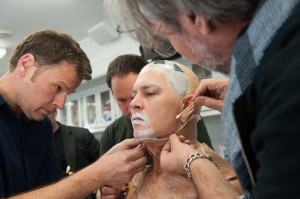 Regarding the Butch Cavendish character, played by William Fichtner, initially the role was going to be cast with Dwight Yoakum who backed out at the last minute. “He didn’t want to wear anything,” said Harlow. “We got Bill, and Gore came to me and said that he didn’t want him to be recognizable. I sculpted his nose and brought that down into the scar on his lip. I had Lenny McDonald make this dental prosthetic and replaced a scar with a silver tooth. It was just going to be Bill Fichtner with a different-shaped nose. It came together magically. We tested it the day before we filmed.”
Regarding the Butch Cavendish character, played by William Fichtner, initially the role was going to be cast with Dwight Yoakum who backed out at the last minute. “He didn’t want to wear anything,” said Harlow. “We got Bill, and Gore came to me and said that he didn’t want him to be recognizable. I sculpted his nose and brought that down into the scar on his lip. I had Lenny McDonald make this dental prosthetic and replaced a scar with a silver tooth. It was just going to be Bill Fichtner with a different-shaped nose. It came together magically. We tested it the day before we filmed.”
In total, Lone Ranger involved 86 speaking parts and hundreds of background players. “Everybody is in some kind of special makeup,” Harlow described. “There is no such thing as just a dirt makeup. [There were] layers of dirt and the color of the earth that we were dealing with in various scenes. We had dirt classes, showing additional artists how we wanted the dirt done. Everyone is wearing a facial hair piece because it’s the 1860s. If you fail on a facial hair, nothing else matters.”
Though Lone Ranger’s main makeup department included five people, Harlow, Smithson, Niederbaumer, Robin Beauchesne and Ann-Maree Hurley, supplemental artists were brought in on location in several states in the American southwest for scenes with background players. “Disney wanted us to use locals,” Harlow said. “Some of them were fantastic. We had 16 locals when we had 280 background people for those big town sequences. Some were cavalry, railroad workers, town people, Comanche, prostitutes, ranchers, shareholders or railroad bureaucrats. All were wearing some kind of facial hair piece.”
In one additional task, Harlow was called upon to create the iconic Lone Ranger mask. “We made the Lone Ranger’s mask to fit Armie’s face carefully,” Harlow said. “We had some lead time on that. It’s so strange how a fraction of an inch higher or lower down on the nose, the more superhero it looks. There were multiple versions — some with the eyeholes wider.”
Given the size of Lone Ranger, one would expect Harlow would want down time after the experience ended, but the opposite is true. “I hate taking time off,” he said. “I love working and doing makeup. Fortunately I had a team who loved doing this stuff as much as I did. We have the guys; we have the materials; it’s just a matter of time. We worked through the weekends and burned the midnight oil.”
In the end, Harlow, who has already won an Oscar for his contributions to 2009’s Star Trek, saw Lone Ranger as a movie whose achievements stood above the uneven critical reception of the overall movie. “The fact that it’s still being recognized for makeup, we are all really grateful and humbled that it’s exceeded the stigma that the movie had,” he said. “Even to make it this far is a tremendous honor.”





